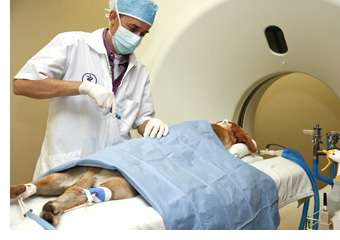
A biopsy is a medical test involving the removal of tissue for examination. The tissue is generally examined under a microscope by a pathologist. Pathologic examination can determine the type of lesion and whether it is benign or malignant. These results provide the veterinarian necessary information for patient treatment. Neurological biopsies can be organized into the following 3 categories:
Incisional (Core) Biopsy
Only a sample of tissue is removed (usually surgical)
- brain: cerebral cortex or cerebellum, neoplasia
- spinal cord: spinal cord tumor caused by lymphosarcoma or parenchymal tumor
- peripheral nerve and/or muscle: after negative results from electrodiagnostics, this surgical biopsy may be performed to confirm a neuropathy (sensory or motor) or a myopathy.
Excisional Biopsy
An entire lesion or mass is removed
- brain and spinal cord tumor removal
Needle Biopsy (CT-Guided)
A sample of tissue or fluid is removed with a needle and syringe. Most needle aspiration biopsies at the Veterinary Neurological Center are aided by the use of CT. Once the exact location of the mass is found, it is marked on the patient and the patient is moved out of the CT to be accessible for the biopsy. At the Veterinary Neurological Center, the biopsy portion of a non-neurological CT-guided biopsy is usually performed by the referring veterinarian who accompanies the patient.
- vertebral body or vertebral mass
- non-neurological: cutaneous, skull, ear, eye
This information is meant to be a guide and not a substitute for veterinary care.
Always follow the instructions provided by your veterinarian.
